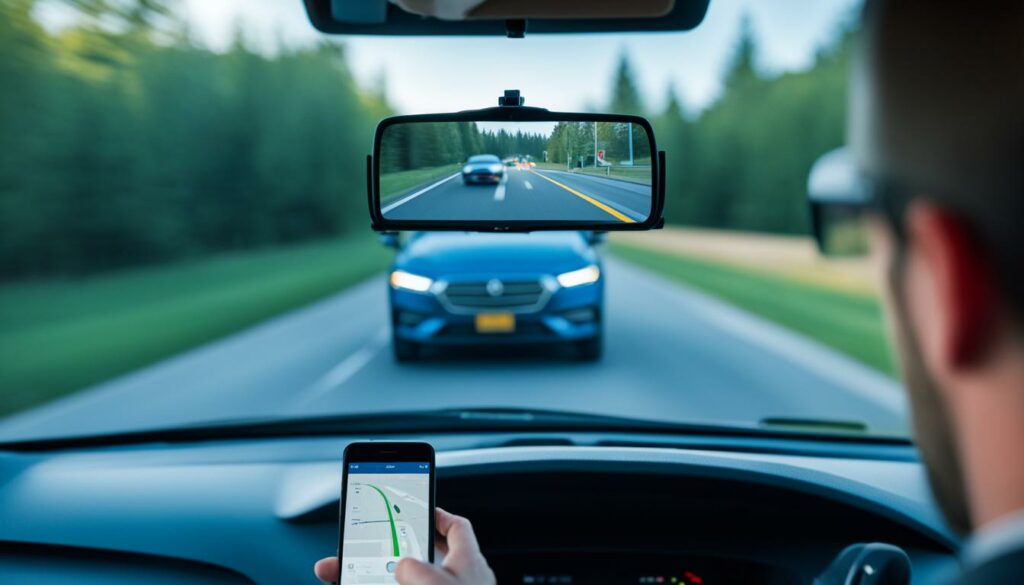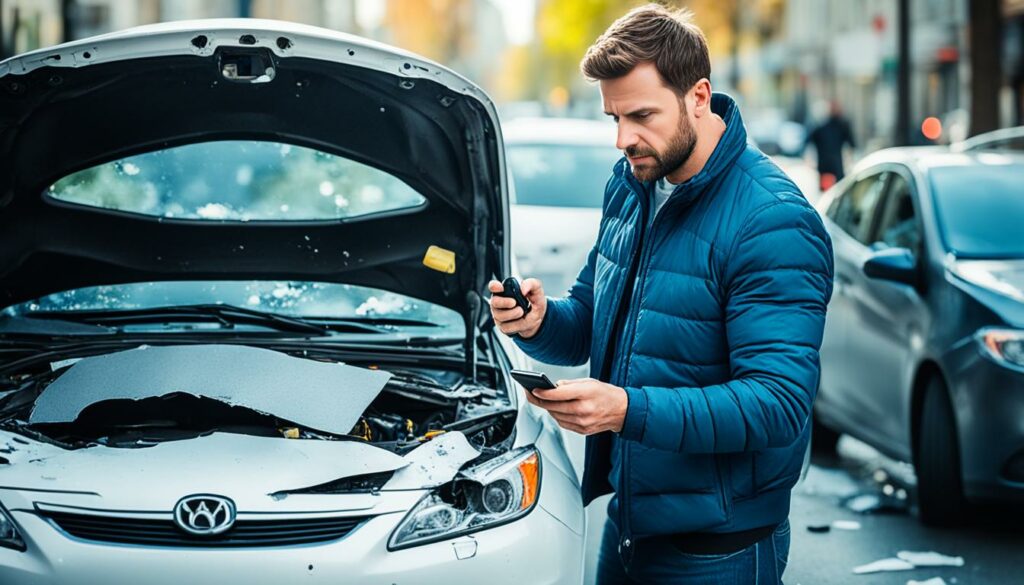What Driving Tips Boost Safety & Efficiency
When it comes to driving, safety and efficiency should always be your top priorities. By following these driving tips, you can enhance your defensive driving skills and develop habits that promote safe and efficient driving.
Driving is a daily activity for many people, but it’s important to remember that even a momentary lapse in attention can have serious consequences. Whether you’re a seasoned driver or a new driver, there are always ways to improve your driving skills and reduce the risk of accidents.
In this article, we will discuss various driving techniques and habits that can boost your safety and efficiency on the road. By implementing these tips into your driving routine, you can become a more confident and responsible driver.
Key Takeaways:
- Implement defensive driving techniques to prevent accidents and promote safe driving habits.
- Always wear your seat belt and avoid driving under the influence of alcohol or drugs.
- Obey traffic laws and be aware of the road safety regulations in your area.
- Prepare your vehicle for winter driving conditions and keep an emergency car kit handy.
- Practice regular vehicle maintenance and stay alert to changing road conditions.
The Basics of Safe Driving

To drive safely, it is crucial to prioritize your focus on the road and avoid distractions. By following these driving tips, you can enhance your safety and reduce the risk of accidents.
1. Avoid Electronic Devices
One of the most common distractions while driving is the use of electronic devices. It is important to refrain from using your phone, texting, or engaging in any other activities that may take your attention away from the road. Remember, it only takes a split second of distraction to cause a hazardous situation.
2. Slow Down and Stay Alert
Speeding not only increases the likelihood of accidents but also reduces your ability to react to unexpected situations. By obeying speed limits and maintaining a safe driving speed, you give yourself more time to react and avoid potential collisions. Additionally, stay alert and be mindful of your surroundings to identify potential hazards ahead.
“Safe driving means being fully present on the road, focusing on the task at hand, and actively minimizing potential distractions.”
3. Ignore Distractions
While driving, it is important to resist distractions and keep your attention solely on the road. This includes avoiding activities such as eating, grooming, or engaging in deep conversations. By staying focused, you increase your ability to anticipate and respond to potential hazards effectively.
4. Obey Speed Limits
Speed limits exist to ensure safe driving conditions for everyone on the road. It is crucial to respect and follow these limits, adjusting your speed based on the road conditions and surrounding traffic. Remember, driving within the speed limit not only enhances your safety but also demonstrates responsible driving behavior.
Keeping these safe driving basics in mind will not only protect you and your passengers but also contribute to the overall safety of the roadways.
Defensive Driving Techniques

Defensive driving is an essential skillset for every driver, as it involves employing specific techniques to prevent accidents and promote safe driving habits. By being proactive and vigilant on the road, you can significantly reduce the risk of collisions and ensure the safety of yourself and others. Here are some defensive driving techniques to keep in mind:
1. Be Aware of Other Drivers
One of the key aspects of defensive driving is being mindful of the actions and behaviors of other drivers around you. Pay attention to their speed, lane changes, and any signs of reckless driving. By anticipating potential hazards, you can react quickly and avoid dangerous situations.
2. Expect the Unexpected
Driving defensively means always expecting the unexpected and being prepared for any sudden changes on the road. This includes anticipating the actions of pedestrians, cyclists, and other vehicles at intersections and keeping a safe distance to allow for unexpected maneuvers.
3. Maintain a Safe Following Distance
Keeping a safe following distance is crucial in defensive driving. By maintaining a significant gap between your vehicle and the one in front of you, you provide yourself with enough time to react if the other driver suddenly brakes or makes an abrupt maneuver.
4. Allow Extra Time in Your Schedule
Rushing to reach your destination can lead to reckless and unsafe driving behaviors. By allowing extra time in your trip schedule, you can alleviate the pressure to speed or take unnecessary risks on the road. Plan ahead and account for potential delays to ensure a stress-free and safe journey.
5. Consider Taking a Defensive Driving Course
If you want to enhance your defensive driving skills and learn advanced accident prevention techniques, consider enrolling in a defensive driving course. These courses provide valuable knowledge and practical training to improve your driving abilities, making you a more confident and responsible driver.
By incorporating these defensive driving techniques into your everyday driving habits, you can significantly reduce the chances of accidents and keep yourself and others safe on the road.
Defensive Driving vs. Aggressive Driving
| Defensive Driving | Aggressive Driving |
|---|---|
| Focuses on accident prevention | Emphasizes speed and aggression |
| Keeps a safe following distance | Tailgates and speeds excessively |
| Anticipates potential hazards | Engages in risky maneuvers |
| Prioritizes the safety of all road users | Displays hostility towards other drivers |
Driving Responsibly

Driving responsibly is an essential part of ensuring the safety of yourself, your passengers, and others on the road. By prioritizing responsible driving habits, you can help prevent accidents and promote a safer driving environment.
One of the most fundamental aspects of responsible driving is wearing a seat belt at all times. Seat belts are designed to protect you in the event of a collision, reducing the risk of severe injuries. Make it a habit to buckle up before you start your journey, and remind all passengers in your vehicle to do the same.
Another crucial aspect of responsible driving is avoiding driving under the influence of alcohol or drugs. Driving while impaired affects your judgment, coordination, and reaction time, significantly increasing the chances of an accident. If you plan to consume alcohol or take medications that may impair your driving ability, it is best to arrange for a designated driver or use alternative transportation options to ensure everyone’s safety.
Responsible driving also includes protecting vulnerable passengers, such as children. Ensure that children are properly secured in age-appropriate car seats or booster seats, following the guidelines provided by the manufacturer. It is essential to minimize distractions from children by engaging them in quiet activities and avoiding turning around to attend to their needs while driving.
Driving responsibly also means being mindful of your physical and mental condition. Avoid driving when fatigued, as drowsiness can impair your judgment and reaction time. If you feel tired during your journey, it is crucial to find a safe place to rest and recharge before continuing. Additionally, be cautious when changing lanes, using your mirrors and turn signals, and always checking blind spots to ensure a safe maneuver.
Remember, driving responsibly is not just a responsibility; it is a commitment to the safety of yourself and others. By practicing responsible driving habits, you can contribute to a safer road environment for everyone.
Driving Responsibly Checklist:
- Always wear your seat belt.
- Avoid driving under the influence of alcohol or drugs.
- Secure children in appropriate car seats or booster seats.
- Avoid distractions from children by engaging them in quiet activities.
- Avoid driving when fatigued.
- Be cautious when changing lanes, using mirrors, signals, and checking blind spots.
By following these guidelines and driving responsibly, you can contribute to a safer road environment and help prevent accidents.
What to Do in Case of an Accident

In the unfortunate event of an accident, it is essential to know the proper steps to take to ensure everyone’s safety and protect your rights. Following accident protocol and reporting a claim are crucial in such situations. Here’s what you need to do:
1. Assess Injuries and Safety
First and foremost, check for any injuries among yourself, passengers, and others involved in the accident. If anyone is hurt or requires medical attention, call emergency services immediately.
2. Exchange Information
Next, exchange contact and insurance information with the other party. Obtain their full name, phone number, email address, insurance company name, policy number, and the vehicle’s license plate number. Provide them with your information as well.
3. Document the Scene
Take pictures or videos of the accident scene, including the damage to the vehicles, road conditions, and any relevant details. This documentation may be helpful when reporting the claim to your insurance provider.
4. Contact Law Enforcement
If necessary, contact the local police or highway patrol to report the accident. Cooperate with law enforcement and provide them with accurate details of the incident.
5. Report the Claim
Notify your insurance provider about the accident as soon as possible. Provide them with all the necessary information, including details about the other party involved. They will guide you through the claims process.
6. Seek Legal Advice if Needed
If the accident involved a hit-and-run or resulted in severe injuries, you may want to consult with an attorney who specializes in personal injury or car accident cases. They can provide guidance and help protect your rights.
Remember, the steps you take immediately after an accident can greatly impact the outcome. By following these guidelines, you can ensure proper documentation, timely reporting, and a smoother claims process.
Important Laws for Road Safety
To practice road safety, it is essential to understand and obey the various traffic laws in place. These laws have been implemented to ensure the safety of all road users and promote a smoother flow of traffic. By following these laws, we can contribute to a safer driving experience for everyone.
Speed Limits
One of the most crucial road safety laws is the enforcement of speed limits. Speed limits are set based on various factors such as road conditions, visibility, and population density. It is important to always adhere to the posted speed limits to reduce the risk of accidents and maintain control of your vehicle. Speeding not only endangers your own life but also puts others at risk.
Parking Regulations
Parking regulations are in place to ensure the efficient and safe use of parking spaces. Whether it’s parking on the street or in designated lots, it is important to follow the designated parking rules to avoid unnecessary congestion and potential accidents. Make sure to park only in designated areas, adhere to time limits, and respect any signage or markings indicating parking restrictions.
Stopping for School Buses
One specific law that contributes to the safety of schoolchildren is the requirement to stop when a school bus has its stop sign displayed. When a school bus stops to pick up or drop off students and activates its stop sign, drivers in both directions are legally obligated to stop. Failing to do so can have serious consequences and put the lives of children at risk.
Obeying traffic laws is not just a legal obligation but also a responsibility to ensure the safety of ourselves and others on the road.
By familiarizing ourselves with and respecting these road safety laws, we can significantly reduce the risk of accidents and create a safer driving environment for everyone. It is essential to remember that road safety is a shared responsibility, and each one of us plays a vital role in promoting safe and responsible driving practices.
| Common Road Safety Laws | Importance |
|---|---|
| Speed Limits | Reduce the risk of accidents and maintain control of the vehicle. |
| Parking Regulations | Promote efficient use of parking spaces and prevent unnecessary congestion. |
| Stopping for School Buses | Ensures the safety of schoolchildren when boarding or deboarding the bus. |
Winter Driving Safety Tips
Winter driving conditions can be hazardous, posing a challenge to road visibility and overall safety. To ensure a safe driving experience during the winter months, it is important to take the necessary precautions and be prepared for sudden changes in weather.
Here are some essential winter driving safety tips:
1. Wear Seat Belts:
Always wear your seat belt while driving, regardless of the weather conditions. Seat belts are essential in protecting you and your passengers in the event of an accident.
2. Stay Alert in Areas Prone to Freezing:
Be extra cautious when driving in areas that freeze quickly, such as bridges, overpasses, and shaded areas. These areas tend to be more slippery and may require reduced speed and increased following distance.
3. Keep an Emergency Car Kit:
Prepare an emergency car kit and keep it in your vehicle throughout the winter season. This kit should include items such as a flashlight, blanket, extra warm clothing, ice scraper, shovel, jumper cables, and non-perishable snacks. In case of an emergency or breakdown, having these supplies readily available will help you stay safe and comfortable.
4. Regularly Check Weather Reports:
Prior to any winter drive, check weather reports and road conditions. This will provide you with the necessary information to plan your route and make informed decisions regarding driving conditions.
| Tips | Benefits |
|---|---|
| Wear seat belts | Reduces the risk of injury during accidents |
| Stay alert in freezing areas | Minimizes the chances of skidding or losing control |
| Keep an emergency car kit | Prepares you for unexpected situations and emergencies |
| Regularly check weather reports | Keeps you informed about the current driving conditions |
By following these winter driving safety tips, you can navigate the roads with increased caution and ensure your own safety, as well as the safety of others around you. Remember, safe winter driving is all about preparedness and being proactive.
Defensive Driving Best Practices for Fleet Drivers
Ensuring fleet safety is paramount for fleet drivers as they navigate the roads on behalf of their organizations. By following defensive driving best practices, fleet drivers can minimize risks and promote safe driving habits among their teams.
Visibility: Maintaining good visibility is essential for fleet drivers to anticipate potential hazards and react promptly. Regularly check and clean all windows, mirrors, and headlights to ensure clear visibility at all times. In adverse weather conditions, such as rain or fog, use appropriate lights and signals to enhance visibility and alert other drivers.
Space Management: One of the fundamental principles of defensive driving is maintaining adequate space around the vehicle. Fleet drivers should always maintain a safe following distance to allow for sufficient reaction time in case of sudden stops or unexpected events. Avoid tailgating and anticipate the actions of other vehicles to prevent collisions.
Communication: Effective communication is vital on the road, especially for fleet drivers who often interact with other drivers and pedestrians. Use turn signals and clear lane-change intentions to communicate your driving maneuvers. Be cautious and patient when merging or changing lanes, allowing other vehicles to adjust accordingly.
Vehicle Maintenance: To ensure optimal performance and safety, fleet drivers should prioritize regular maintenance for their vehicles. This includes routine inspections of tires, brakes, lights, and fluid levels. Properly maintained vehicles are less likely to experience mechanical failures that could lead to accidents.
To summarize, fleet drivers should prioritize defensive driving practices to enhance fleet safety. By maintaining visibility, managing space effectively, communicating with others, and practicing regular vehicle maintenance, fleet drivers can contribute to a safer driving environment for themselves and the community.
Conclusion
Safe driving is essential for your well-being and the well-being of others on the road. By incorporating defensive driving tips into your daily routine, you can significantly enhance your safety and efficiency while driving. Remember to always prioritize defensive driving skills and habits to minimize the risk of accidents.
Remaining alert and focused on the road is crucial. Avoid distractions such as texting or using your phone while driving. It is important to obey traffic laws and speed limits to maintain a safe driving environment for everyone. By doing so, you contribute to responsible driving behavior.
Implementing defensive driving techniques, such as maintaining a safe following distance and being aware of your surroundings, can greatly reduce the likelihood of accidents. By taking additional defensive driving courses, you can further improve your skills and be better prepared for unexpected situations on the road.
In conclusion, safe driving is a combination of adopting defensive driving habits, obeying traffic laws, and staying focused on the road. By following the defensive driving tips mentioned in this article, you can ensure a safer driving experience for yourself and others around you.
FAQ
What are some driving tips to boost safety and efficiency?
Follow these driving tips to enhance your defensive driving skills and develop safe driving habits.
How can I drive safely?
Avoid distractions and stay focused on the road. This includes refraining from using electronic devices while driving and slowing down to have more time to react. Ignoring distractions and obeying speed limits are essential for safe driving.
What is defensive driving?
Defensive driving involves using techniques to prevent accidents and drive safely. It’s important to be aware of other drivers and expect the unexpected. Maintaining a safe following distance and allowing extra time in your trip schedule are key defensive driving techniques. Taking a defensive driving course can also enhance your skills.
How do I drive responsibly?
Drive responsibly by wearing a seat belt at all times and not driving under the influence of alcohol or drugs. Ensure that children are properly buckled and not creating distractions. Avoid driving when fatigued and be cautious when changing lanes.
What should I do in case of an accident?
Assess any injuries and check on the well-being of others involved. Follow accident protocol by exchanging contact and insurance information. Report the claim to your insurance provider and cooperate with law enforcement.
What are some important road safety laws?
Obey traffic laws, such as not passing a stopped bus displaying a stop sign, adhering to speed limits, and following parking regulations. Understanding and following these laws can help ensure a safer driving experience.
How can I drive safely during winter?
Take precautions by wearing seat belts, staying alert in areas that freeze quickly, and keeping an emergency car kit in your vehicle. Regularly check weather reports and be prepared for winter driving conditions.
What are some defensive driving best practices for fleet drivers?
Fleet drivers should prioritize visibility, space management, communication, and be aware of their vehicle’s capabilities. Regular maintenance is also crucial for fleet safety.
How can I ensure safe driving?
Implement these safe driving tips and defensive driving techniques. By prioritizing defensive driving skills and habits, you can reduce the risk of accidents and promote responsible driving behavior. Remember to always be alert, obey traffic laws, and stay focused on the road for a safer driving experience.







